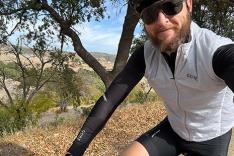Flash forward to when I was 23 and was on a regional development team. We would be climbing and I would be at 165 beats per minute while my partner riding right beside me was at 185 beats per minute, with both of us working at about the same overall exertion level. This was good evidence that heart rate by itself is not a valid point of comparison between cyclists.
Another example from that time. Our coach would prescribe intervals where our heart rates should be about 180 beats per minute. However, there was no way I could do anywhere close to that, to which his response was simply that I should work harder. Not surprisingly, it was about that time that my personal interest in sport science got even deeper!
How has my maximal heart rate changed, if at all, in the twenty years since? According to the 220 -- age equation, my maximal heart rate should actually now be at 220 -- 42 or 178 beats per minute. However, in all my lab and field testing, I cannot find a maximal heart rate above 165 beats per minute in the past four years.
So let's use me exercising at 70 percent as an example.
- My twenty-something training HR would be 70% * 175 = 123 beats per minute.
- My current training HR would be 70% * 165 = 116 beats per minute.
More: How to Use a Heart-Rate Monitor
Heart Rate Reserve
Another way of quantifying heart rate training intensity is to base it on your "heart rate reserve" or HRR. Your HRR is calculated from both your maximal and your resting heart rate. As an example, your HRR might be 175 (maximal heart rate) -- 55 (resting heart rate) = 120.
Your exercise intensity might then be described as 50 percent HRR for an endurance effort. So using the above values as an example, this would be:
Baseline HR + 50 percent HRR, or
- 55 + (50%)(175-55)
- 55 + (50%)(120)
- 55 + 60 = 115 beats per minute.
The advantage of the HRR concept is that it integrates both your minimum and maximum heart rate values, rather than simply your maximum heart rate. For example, you may have two cyclists with the same maximum heart rate of 175 beats per minute. But if Cyclist A and B have resting heart rates of 50 versus 75 beats per minute, this intuitively should make sense that the two cyclists might need different heart rate levels to achieve a particular training intensities.
Using my example again, let's figure out 70 percent training targets. My resting HR has not really changed in 20 years, staying at 50 beats per minute:
- * My twentysomething value = 50 + (70%)(175-50) = 138 beats per minute. * My current value = 50 + (70%)(165-50) = 131 beats per minute.
More: Heart Rate Training Tips for Runners
Steady State Heart Rate
A third way to normalize heart rate training levels is to anchor heart rates based on the average values that you might achieve during a 20-30 min time trial. Those of you training with power may see that this is very analogous to the 20 min test for functional threshold power. This is based on the idea that, this is the "maximal" heart rate you can realistically sustain for a prolonged hard effort, and therefore forms the best anchor for your training levels.
In my case, this threshold heart rate really has not changed at all in more than 20 years of riding, racing, and testing. Despite my maximal heart rate decreasing by 10 beats per minute, and my functional threshold power changing over the course of a season and through the years, my threshold heart rate over a 20-minute time trial or test has remained essentially constant at 155 beats per minute.
In this case, my 70 percent training level in both my 20s and now would be:
70% multiplied by 155 = 109 beats per minute.
Summary
The critical lessons?
1. Do not rely on average values or estimates. Base things on your own values!
2. There is never a case of "highest/lowest heart rate wins!" All testing and training should be individualized, and the value of your data comes when you track your own training long-term.
3. I used a set "70 percent" to illustrate that different ways of anchoring your heart rate will get you different heart rate values. Of course, it is not automatic that a 70 percent is meant to represent the same training intensity (e.g. endurance) for each method! We will explore the concept of what might be an optimal heart rate training intensity in my next Toolbox.
4. You will likely need to change your heart rate training levels over the course of a season, or as you age.
Ride safe and have fun!
More: Use a Heart-Rate Monitor to Avoid Over- or Under-Training
 Ready to ride? Search for a cycling event.
Ready to ride? Search for a cycling event.- 2
- of
- 2








Discuss This Article